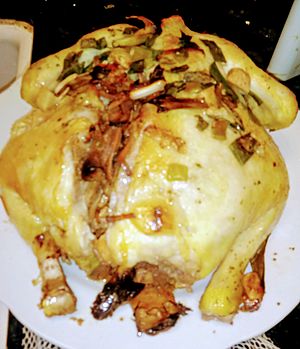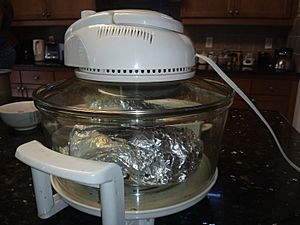Beggar's chicken facts for kids

A dish of beggar's chicken, prepared in California
|
|
| Alternative names | Rich and noble chicken Baked stuffed chicken Hangzhou simmer chicken Yellow mud simmer chicken Foiled chicken (a simplified version) |
|---|---|
| Type | Stuffed chicken dish |
| Place of origin | China |
| Region or state | Changshu, Jiangsu province |
| Main ingredients | Chicken, marinade, and stuffing with variety of ingredients |
| Beggar's chicken | |||||||||||
|---|---|---|---|---|---|---|---|---|---|---|---|
| Simplified Chinese | 叫化鸡 | ||||||||||
| Traditional Chinese | 叫化雞 | ||||||||||
| Hanyu Pinyin | jiàohuā jī | ||||||||||
| Literal meaning | beggar's chicken | ||||||||||
|
|||||||||||
Beggar's chicken (simplified Chinese: 叫化鸡; traditional Chinese: 叫化雞; pinyin: jiàohuā jī) is a special Chinese dish. It's made by stuffing a whole chicken, wrapping it in lotus leaves (or sometimes banana or bamboo leaves), and then covering it in clay or dough. The chicken is then baked very slowly using low heat. This slow cooking can take up to six hours! It makes the chicken super tender and full of flavor.
Contents
The Story Behind Beggar's Chicken
Beggar's chicken is a very popular dish in China, and many places say it started there. Most food experts believe it first came from Hangzhou. The idea of cooking food wrapped in clay has been around for thousands of years!
There are many fun legends about how Beggar's Chicken got its name.
The Clever Beggar's Discovery
One popular story tells of a poor beggar who stole a chicken from a farm. He didn't have any pots or cooking tools. So, he wrapped the chicken in big lotus leaves. Then, he covered it completely with wet clay or mud. He dug a hole, started a fire, and buried the clay-covered chicken in the hot ashes.
When he dug it up later and cracked open the clay, he found something amazing! The chicken was incredibly tender and smelled wonderful. The clay had sealed in all the juices and flavors.
A Dish Fit for an Emperor
In some versions of the story, the beggar stole the chicken from an emperor. He used the mud-hole cooking method to avoid making smoke that might attract the emperor's guards. Another tale says an emperor once stopped to eat with the beggar. The emperor loved the dish so much that he added it to his royal menu! The beggar then became successful selling his special chicken to everyone.
Another legend says that this dish was a favorite food of Emperor Gaozu of Han when he was a child and a peasant. When he became emperor, this simple chicken dish became a royal specialty.
How Beggar's Chicken is Made Today
Today, cooks often use dough instead of clay to wrap the chicken. This is usually safer and easier. However, some recipes still use special non-toxic clay to keep the chicken moist and flavorful.
Cooking Methods
Beggar's chicken can be cooked in many ways:
- In regular ovens
- On outdoor grills
- In smokers
- Over campfires
If you use clay, you need to be careful with the heat. Too much heat can make the clay shell crack. Using dough is often safer. You can also use special ceramic cooking pots to keep the moisture in, but these can be expensive.
Modern Shortcuts
For cooking at home, some people use an oven bag inside a regular oven. A convection oven can also cook the chicken evenly without needing a heavy clay or dough cover. Even then, the chicken is usually wrapped in lotus leaves and then in aluminum foil. This faster and simpler version is sometimes called "foiled chicken."


